10+ SAMPLE Harassment Investigative Report
-
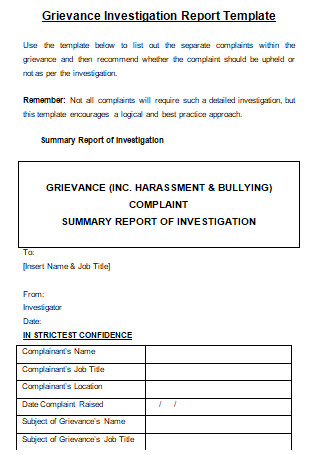
Harassment Investigative Report Template
download now -
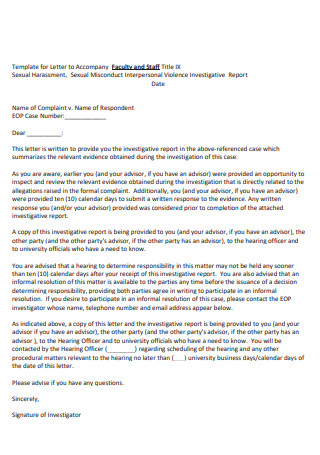
Sexual Harassment Investigative Report
download now -
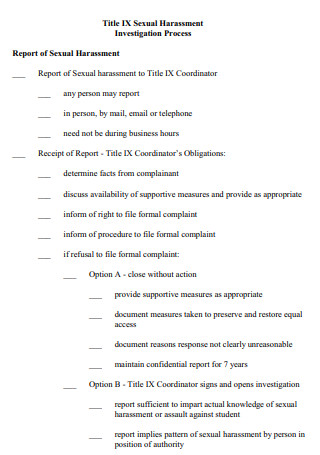
Sexual Harassment Investigative Process Report
download now -

Harassment Investigative Report
download now -
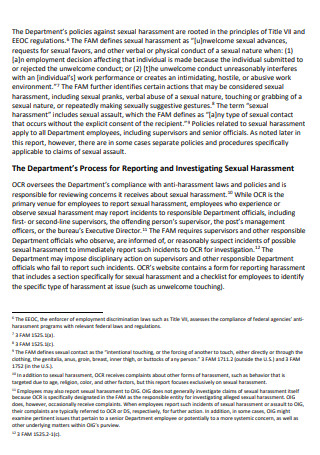
Department Process Harassment Investigative Report
download now -
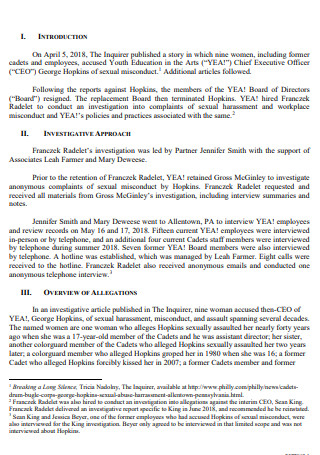
Sexual Harassment Workplace Investigative Report
download now -
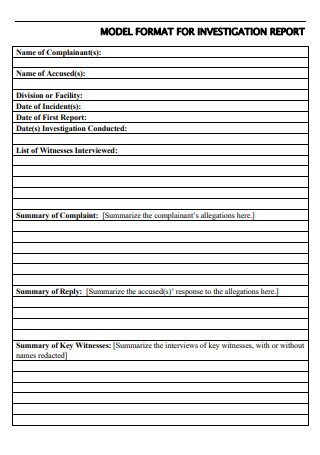
Harassment Investigative Report Format
download now -
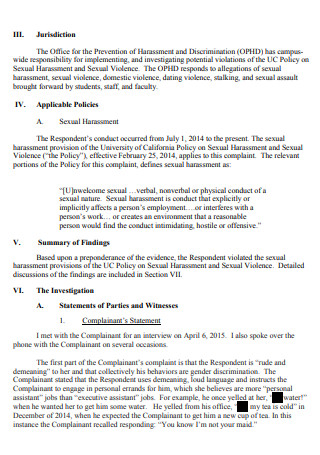
Harassment And Discrimination Investigative Report
download now -
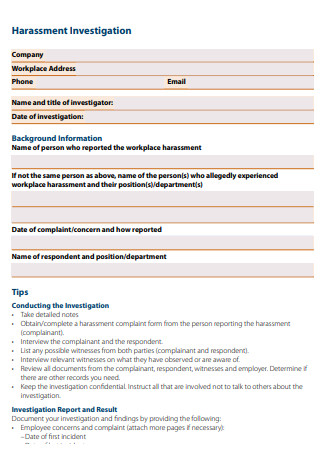
Workplace Investigative Report
download now -
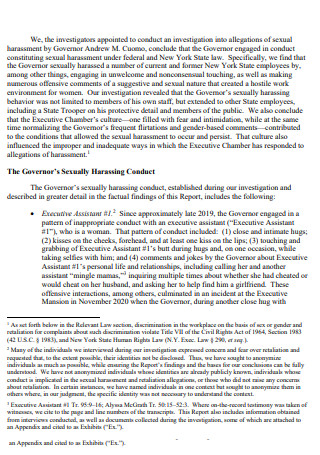
Allegations of Sexual Harrasment Investigative Report
download now -
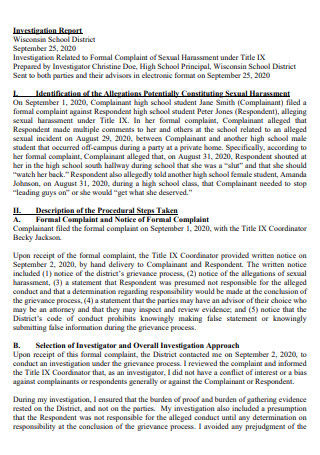
Harassment Investigative Report Example
download now
FREE Harassment Investigative Report s to Download
10+ SAMPLE Harassment Investigative Report
What Is Harassment?
What Is a Harassment Investigative Report?
What Is The Importance of Conducting Investigation of Harassment?
What Are The Types of Harassment?
How To Know If You Are Being Harassed?
Who Are Usually The Victims of Harassment?
FAQs
What can I do if I am being harassed?
What should I do if I witness someone being harassed?
How do you give a safe space for people or victims of harassment?
What Is Harassment?
Harassment is an unwelcomed behavior which is offensive or gives the feeling of being humiliated or intimidated. This can happen anywhere at any time. Harassment can take place at the workplace, along the road, at home, at school, and just anywhere. It can be possibly done in many different scenarios as well, including exchanges in hallways, after-hours conversations, inside the public utility vehicle, or through the use of social media.
Harassment becomes an unlawful discrimination if it has something to do with the age, disability, gender reassignment, race, religion or belief, sex, and sexual orientation.
According to United Nations (UN), globally, the massive number of victims are mostly women, it is estimated to be around 736 million women—which is almost one in three—who have been subjected to violence and harassment for at least once in their life. It is mentioned that 30% of these women are aged 15 and older.
The World Health Organization (WHO) revealed that COVID-19 pandemic has further increased women’s exposure to violence due to lockdowns and disruptions to vital support services.
A statement coming from National Sexual Violence Resource Center (NSVRC) details that in United States, there is 81% of women and 43% of men reported to have experienced different forms of sexual harassment and/or assault in their lifetime.
This statistics is already huge and we haven’t even discussed about the other forms of harassment. Yet.
What Is a Harassment Investigative Report?
A Harassment Investigative Report is a thorough and detail-oriented investigation. Its purpose is to make a decision as to whether the allegation/s of harassment as defined by Law are founded or unfounded. It contains a credible information that give credence to the investigator’s findings. Moreover, there should be the presence of an analysis that brings together all of the relevant evidence and facts identified. This is a process where each allegation must be analyzed and identified separately, and they also need to be considered as a whole, to establish whether there is a pattern of repetitive harassing behavior over time. This also includes the conclusion that is based upon the analysis in the preceding section. To be inconclusive, however, is not a valid result. This section should clearly state whether: a) The alleged behavior does or does not constitute “harassment”
b) On the balance of probabilities, the given evidence does or does not support the allegation(s) that the behavior took place and;
c) A breach of the organization’s Harassment Prevention Plan has, or has not, taken place. Lastly, in the recommendations section, per the mandate provided to the investigator, there may or may not be recommendations provided in the report.
What Is The Importance of Conducting Investigation of Harassment?
The importance of conducting investigation about harassment is to explore in detail the allegations, to examine in depth, and to determine specifically whether academic research misconduct has been committed, and if so, the responsible person will face the seriousness of the misconduct.
What Are The Types of Harassment?
There are several types of harassment that falls in different categories.
How To Know If You Are Being Harassed?
If a person has a repetitive behavior in a way that alarms or distresses you, you are being harassed. It could be like: sending you texts, letters, food, or gifts that you do not want. Here are some signs of being a victim of harassment:
You feel uncomfortable. Harassment, to a degree, is seen subjectively and takes the expression “bad vibes” to a different level. One example is in a workplace, although, it is to remain professional, there will be the presence of social interaction with other co-workers, setting the scene for how most inappropriate behavior occurs. Some inappropriate behavior in a workplace may be shameless, like a slap on the buttocks, moving a person by the waist, or other things that may be subtler such as sensual touching disguised as as an accident. Bear in mind that even emails or text messages can be a mechanism for doing unwelcome sexual behavior. These advances may be obvious or indirect, the main issue is when they are unwanted. What if you are unsure? One way to identify harassment is to listen to your gut.
You are experiencing unwanted physical contact. This common form of unwanted advances is if someone is touching you and it is an unwelcomed one. Some examples may be rubbing shoulders, pushing up against each other, expressions of physical affection, hugging, using objects to touch another, or even using one’s body to block you from going somewhere. Even if it can be seen accidental or harmless, you have the right to feel safe and free in that certain situation.
Saying “NO” has no impact. In a situation where someone likes you and the person continues to pursue you even after saying NO to them, it is considered harassment. This disturbs your peace and your safety.
You are being treated differently based on your sex. If you are being treated in a particular way because you are a man or a woman, this means you are being singled out and treated based on your sex. This has an adverse impact on you and this may be considered sexual harassment.
You were asked for sexual favor. A situation where you are offered something of value in exchange for sexual favors. It is when a person in a position of power threatens to impose an action against you if you rejected the sexual favor.
You are being subjected to jokes or images of a sexual nature. You may still be sexually harassed by images or pranks that are sexual even if you are not being hit on or the object of someone’s affection. There are mechanisms considered to potentially deliver forms of harassment like through emails, texts, videos, cartoons, etc.
You become a victim of revenge. One of the essential aspects of maintaining an employment position is job security. If you have denied a superior’s advances, you may feel like your job is at risk. If they punish you for not doing what they asked, it is already considered harassment.
You feel unsafe. If you do not feel safe in an environment because of its sexual nature, this is already a strong indicator that you are a victim of harassment.
Who Are Usually The Victims of Harassment?
Anyone, regardless of color, age, race, religion, sex, ancestry, could be a victim of harassment or discrimination. In a recent study, women are much more likely to be victims of harassment because of vulnerability, insecure positions, lack of self-confidence, or have been socialized to suffer in silence.
FAQs
What can I do if I am being harassed?
If you are being harassed by a coworker, you can talk with your supervisor. Explain what has happened, ask for help in order for that unwanted behavior to be stopped. The law protects you from retaliation for complaining about harassment. If you are being harassed by a stranger, you may ask help from people around you, you may also report to the police, or always keep a self-defense kit in your pocket.
What should I do if I witness someone being harassed?
Most people cannot tell right away if they are being harassed or not. It is better to stand up for the victim but be sure to be in an area where there are people who can help just in case the harasser decides to attack you. You can also pretend to know the victim and discreetly tell them what is going on without causing a scene.
How do you give a safe space for people or victims of harassment?
Giving a safe space for the victims of harassment is not up for a debate. Accept what happened to them, do not use their experiences against them, give them the freedom to express themselves, and make sure you are well-aware of such sensitive topics so you will know how to talk to them.
In this recent time, there is an exponential growth of victims of harassment. Although there are campaigns and laws being made for the safety and awareness of everyone, it is still prevalent and existing. The daily struggle of most victims do not end but with the presence of Harassment Investigative Report, there is the statistics and documentation of statements and facts coming from people who experienced harassment, which means, this is a proof that this happens. Most people dismiss this topic because it has been a part of the culture or considered very common that they think this does not mentally exhaust victims.
The safe space should start with us. We need to listen to people’s stories because harassment will remain if victim-blaming continues.
